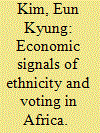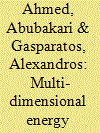|
|
|
Sort Order |
|
|
|
Items / Page
|
|
|
|
|
|
|
| Srl | Item |
| 1 |
ID:
176488


|
|
|
|
|
| Summary/Abstract |
The existing literature has demonstrated that both ethnic and economic factors affect a vote decision in African democracies. I show that there is a meaningful interaction between the two cleavages in their influence on voting. In particular, I argue for political salience of agricultural subsectors that shape the electoral consequences of economic performance in the context where agricultural policy affects the livelihood of the majority population. Relying on the analyses of the 2007 and 2013 elections in Kenya, I illustrate how likely an individual, who is attached to a politically coherent ethnic group, votes for a candidate, the majority of whose ethnic members engage in the same industry as the voter himself regardless of the candidate's ethnicity. The results show that the sector factor reinforces the positive and negative effects of ethnic communities on incumbent support, and also explains voting by ethnic minorities whose motives for voting are not ethnic.
|
|
|
|
|
|
|
|
|
|
|
|
|
|
|
|
| 2 |
ID:
099338


|
|
|
|
|
| Publication |
2010.
|
| Summary/Abstract |
Despite being a major petroleum producing and exporting country, Nigeria has for a long time imported refined petroleum products for domestic consumption. The country has recently made an entrance into the bio-energy sector by seeding the market with imported ethanol until enough capability exists for the domestic production of ethanol. The Nigerian Biofuel Policy was released in 2007 calling for the domestic production of bio-ethanol to meet the national demand of 5.14 billion litres/year. Some investors have responded by investing over $3.86 billion for the construction of 19 ethanol bio-refineries, 10,000 units of mini-refineries and feedstock plantations for the production of over 2.66 billion litres of fuel grade ethanol per annum. Also, another 14 new projects are in the offing. Of the 20 pioneer projects, 4 are at the conception phase, 8 are in the planning phase, and 7 are under construction with only 1 operational. The potential benefits of the emerging bio-ethanol projects include investment in the economy, employment, energy security and boost rural infrastructure, while the major challenge is land take (859,561 ha). This is the first time an attempt is been made to document the emerging bio-ethanol projects in Nigeria.
|
|
|
|
|
|
|
|
|
|
|
|
|
|
|
|
| 3 |
ID:
169737


|
|
|
|
|
| Summary/Abstract |
Ethanol biofuel demand in Brazil is highly dependent on macroeconomic and policy drivers, making it difficult to anticipate future production and associated environmental implications. Here we develop scenarios of ethanol demand in Brazil towards 2030, based on a thorough examination of key influencing drivers, i.e. GDP and population growth, fleet composition, blending policies, fuel prices and energy efficiency. We then estimate their land-use implications using a detailed partial equilibrium model, GLOBIOM-Brazil. We find that ethanol demand is highly sensitive to the drivers considered and could increase between 37.4 and 70.7 billion litres in 2030 depending on the scenario. Such increase is 13% and 114% above the 2018 production. This represents an expansion in sugarcane area between 1.2 and 5 million hectares (14%–58% above the land-use in 2018). Compared to the low demand scenario, a high demand for ethanol in 2030 would drive sugarcane expansion mostly into pastureland (72%) and natural vegetation mosaics (19%). Our results suggest that future ethanol demand in Brazil should not substantially affect food production nor native forest. This outcome will however depend on the compliance with the sugarcane agro-ecological zoning (AEZ) by the ethanol sector in Brazil, a key assumption of our projections.
|
|
|
|
|
|
|
|
|
|
|
|
|
|
|
|
| 4 |
ID:
144844


|
|
|
|
|
| Summary/Abstract |
The promotion of intensive farming through organic and fair trade certification appears contradictory to the increasing significance of non-farm income sources in rural Asia as well as in many other parts of the rural South. By observing a sugarcane producer co-operative comprising land reform beneficiaries in the Philippines, this paper explores the reality of livelihood diversification as practised by member households of the certified co-operative, focusing on the compatibility of certification-supported farming with diversified activities. In this case, diversification at the household level progressed both away from farming and into farming. Behind the long-term use of agricultural certification, there are compelling reasons for continuing both certification-supported farming and diversified activities, and for employing mechanisms that further the compatibility at all phases between the former and the latter, and maximising income-generating opportunities. The operation of communal land with agricultural certification may be an effective form of assistance to land reform beneficiaries who share a strong desire to be landowners.
|
|
|
|
|
|
|
|
|
|
|
|
|
|
|
|
| 5 |
ID:
171401


|
|
|
|
|
| Summary/Abstract |
Several countries across sub-Saharan Africa have promoted industrial crops to boost rural development, including rural energy poverty alleviation. However, little evidence exists about the intersection of rural development and energy poverty in industrial crop settings. We undertake a household survey to explore multidimensional energy poverty patterns around three operational industrial crop projects in Ghana (oil palm, jatropha, sugarcane). We conduct 850 surveys with households with different involvement in these projects (e.g. plantation workers, smallholders), as well as household not involved (i.e. control groups). Overall, distinct patterns emerge between sites and groups, reflecting the different area, project and household characteristics. Jatropha and oil palm plantation workers register lower energy poverty levels than their respective control groups, while oil palm and sugarcane smallholders register either the same (or higher) energy poverty. This is largely because income from engagement in industrial crop activities can reduce energy poverty for some groups, but only where modern energy options are readily available. In reality, other factors can be equally important, including other livelihood activities (e.g. sugarcane/palm oil processing) and the gender of household head. Such distinct patterns and local dynamics must be understood when aiming to achieve positive energy poverty alleviation outcomes through industrial crop expansion.
|
|
|
|
|
|
|
|
|
|
|
|
|
|
|
|
| 6 |
ID:
109604


|
|
|
|
|
| Publication |
2011.
|
| Summary/Abstract |
The Cane Resources Network for Southern Africa evaluated how bioenergy from sugarcane can support sustainable development and improve global competitiveness in the region. The assessment of six countries with good contemporary potential for expanding sugarcane cultivation described in this paper was part of their analysis. Its principal objective was to identify land where such production will not have detrimental environmental and/or socio-economic impacts. Geographic Information Systems (GIS) was used to interrogate 1 km2 resolution protected area, land cover, climate, elevation and soil data sets. To avoid detrimental impacts on biodiversity, all categories of protected areas, closed canopy forests and wetlands were excluded. To safeguard food security, all areas under food and/or cash crop production were excluded. Areas unsuitable because of climate, terrain and soil constraints were also excluded. The assessment found that almost 6 million hectares of suitable land is available in these countries, clearly suggesting that 'land' is unlikely to be a limiting factor in harnessing sugarcane's bioenergy potential in the region. However, land identified as such in this study needs to be verified using better resolution, preferably ground, information.
|
|
|
|
|
|
|
|
|
|
|
|
|
|
|
|
| 7 |
ID:
124225


|
|
|
|
|
| Publication |
2013.
|
| Summary/Abstract |
The State of Paraná contributes significantly for the Brazilian production of sugar cane, ethanol, soybeans and pigs. In addition to the current production of ethanol, the State has a huge potential for electricity, biodiesel and biogas production. This paper presents an overview of the current situation regarding energy generation from the agricultural sector in the State, an assessment of the potentialities of energy generation from sugar cane residues and pig agricultural chains, as well as an analysis of the socioeconomic factors underlying the availability of feedstock for biodiesel production. This study has shown that it is possible to expand the energy supply in the State using residual biomass from the sugar cane and pig production. On the other side, the biodiesel production increase in the State will depend on the expansion in the consumption of products that use the cake as raw material; the increase in the feedstock availability other than canola, castor beans and sunflower; the increase of the number of family farmers as feedstock providers, so as to ensure access for biodiesel producers to the Social Fuel Stamp.
|
|
|
|
|
|
|
|
|
|
|
|
|
|
|
|
| 8 |
ID:
188566


|
|
|
|
|
| Summary/Abstract |
During the 2000s, the development of flex-fuel automotive vehicles in Brazil and rising international commodities prices allowed the Brazilian sugar-ethanol sector to grow at higher rates and expand area planted to sugarcane relative to levels verified in the 1990s. However, this land expansion increases the pressure on land-use change and management. This paper seeks to estimate the technical efficiency and decompose the total factor productivity (TFP) in the sugar-ethanol industry using a stochastic frontier framework. Primary data was obtained from an unbalanced panel of 90 sugar and ethanol producers for the harvest years from 2012/2013 to 2016/2017, providing 209 valid observations. Results suggest that mills have a small gap to increase their efficiency under the current technology, and the industry's TFP has been primarily impacted by the efficiency effects, on the other hand, SE mills might improve TFP rising their scale of production. Therefore, the results in this paper suggest that small SE mills may benefit from merging with other mills to explore economies of scale to enhance their TFP and strengthen economic competitiveness, contributing to the Brazilian environmental policy agenda.
|
|
|
|
|
|
|
|
|
|
|
|
|
|
|
|
| 9 |
ID:
174988


|
|
|
|
|
| Summary/Abstract |
Fostered by environmental and economic drivers, liquid biofuels are expanding in the global energy matrix. However, many countries with biofuel potential, such as Guatemala, have yet to develop domestic biofuels markets. During the last decade, ethanol production in Guatemala has increased significantly, yet a domestic market does not appear to be in the horizon. It is a kind of paradox: a world class sugarcane producer and ethanol exporter does not use any blend of ethanol and gasoline in vehicles. This paper presents a techno-economic analysis and review of barriers that have delayed ethanol-gasoline blends in Guatemala. The cost assessment considers data from an existing distillery in Guatemala. Results show that Guatemala could produce annually a maximum of 250 million liters of ethanol from molasses, more than the amount required to introduce E10. For the current conditions, results from the modelling indicate that the cost of ethanol has minimal impact on the price of E10, but taxes could represent one third of the cost of E10 at the retail level. Since supply conditions are favourable and technical barriers are not relevant, strong government intervention and a coherent price structure for ethanol-gasoline blends is needed to create an ethanol market in Guatemala.
|
|
|
|
|
|
|
|
|
|
|
|
|
|
|
|
|
|
|
|
|